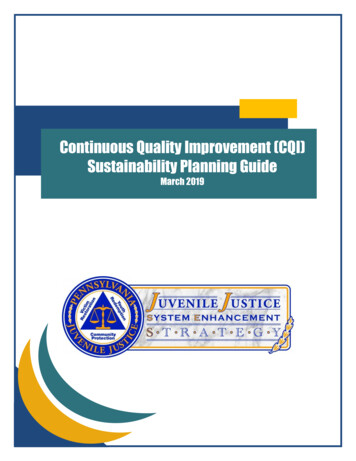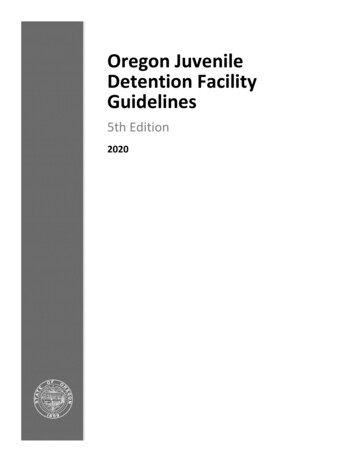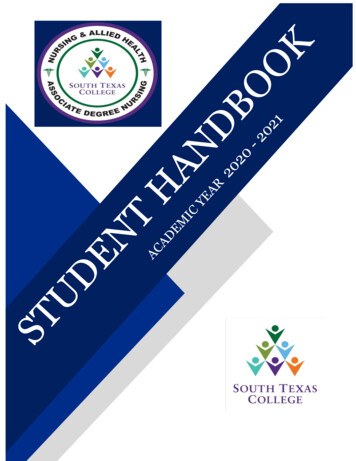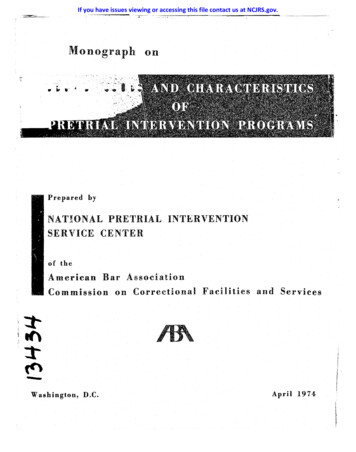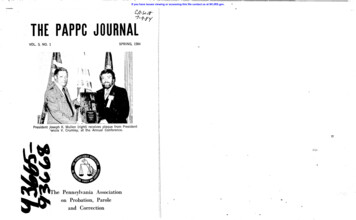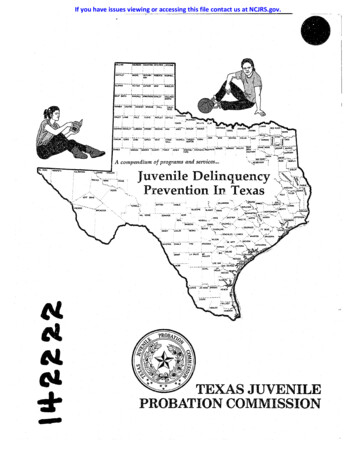
Transcription
If you have issues viewing or accessing this file contact us at NCJRS.gov., flMA IHANSFCflD; E,\,PSCCMJAM:';, TriY- .-.- - : HH: ROe RTS" tf:i.FtiiiiDHAM. ·.·. '.· .: "Ei-fcARScH--!GRAf - -·-· M: LEF.ii.,;;0;;,""" 'Niiil':FOCii!:y. " V:s.," - cAST·RO . ;S :BRtSCot ;'HiLL-· ":C.c:-o:' .I'RtSSA compendium of programs and services .;,.",.".I\.,t.OVH:; ,WHlLER":' EV:S''''-: W4R0 " . ;cWit . : . -', Juvel1ile DelinquencyPrevention In,. TexasTEXAS JUVENILEPROBATION COMMISSION7
DELINQUENCY PREVENTION IN TEXASACOMPENDIUM OF SERVICES142222U.S. Department of JusticeNationallnst!tute of JusticeThis document has been reproduced exactly as rec ived from t eperson or organizaticn originating it. Points of view or oplnl ns stated Inthis document are those of the authors and do not ecessanlY r.epresentthe official position or policies of the National Institute of Justice.Permission to reproduce this copyrighted material has beengranted byTexas Juvenile ProbationCommissionto the National Criminal Justice Reference Service (NCJRS).Further reproduction outside of the NCJRS system requires permissionof the copyright owner.TEXAS JUVENILE PROBATION COMMISSIONBernard Licarior , Ph.D., Executive DirectorP. O. Box 13547Austin, Texas 78711-3547(512) 443-2001Published January, 1993The Texas Juvenile Probation Commission, an equal employer, does not discriminate on the basis of race, color, nationalorigin, sex, religion, age or disability in employment or the provision of services, programs or activities. In compliance withthe Americans with Disabilities Act, this document may be requested in alternative formats by contacting the Texas JuvenileProbation Commission at the above address.
INDEXPage No.PROGRAMS1.Ir.troduction12."Choices" Programs33.Community Service Restitution Programs74.Constructive Activity Programs135.Education/Awareness Programs196.Employment/VocationallWork Study Programs297.Family Programs318.First Offender/Shoplifter Programs379.Foster Home Programs4510.Intensive Supervision (Service) Programs4711.Mediation Programs5112.Outreach Programs5313.Reintegration/Independent Living Programs5714.Religious Programs5915.Specialty Offender Programs6116.Status OffenderlTruancy/Drop-out Programs6317.Substance Abuse Treatment and Prevention Programs7118.Teen Court Programs8519.Volunteer Programs8720.Delinquency Prevention Services95iii
INTRODUCTIONApproaches to delinquency prevention span a wide spectrum of philosophies, servicesand models.Contemporary professionals have identified three basic phases ofprevention. Primary prevention is concerned with preventing children at risk ofbecoming juvenile offenders from committing first time offenses. Secondary prevention involves intervention with juvenile offenders in the.early stages of their offending histories to prevent further involvement in thejuvenile justice system. Tertiary prevention deals with rehabilitation of hard-core, serious offendersfor their return to acceptable social and occupational functioning in thecommunity.Traditionally, the criminal justice system has invested the bulk of available time, effort andfinancial resources to deal with offenders who pose a threat to society. The majority ofthese individuals usually are well establiShed in their life patterns and have developedperpetual careers in crime. Rehabilitation of these offenders is extremely difficult becausecriminal behavior is deeply ingrained in their personalities. Although some are amenableto treatment, oftentimes the best that can be hoped for is to control further criminalactivity by confinement and surveillance.With a burgeoning prison population and overtaxed juvenile corrections system, fewoffenders will have their behavior "controlled" long enough to ensure they do not reoffend. Recent studies have shown that it will be virtually impossible to stem the tide ofcriminal activity by simply building more prisons.The answer lies in diverting these individuals from criminal careers before they areestablished. There is strong agreement among criminal justice professionals that thisprocess must begin early, before the potential offenders come to the attention of thejuvenile justice system, or as soon as possible after referral for an offense.Historically efforts have been focused on youngsters after they offend, but now the publicand criminal justice profession must re-adjust their thinking and priorities to directattention to at-risk juveniles before they become offenders. This means that instead ofwaiting until a child is subject to juvenile laws, (10 years of age in Texas) we must beginour work much earlier in the formative years when children are more malleable and lifebehavior patterns are just emerging. Access and identification are key areas of concernin implementing such an initiative, but one common element all children share that lendsitself to identification and access is our public school system.1
At··risk children usually reveal numerous symptoms early on that are recognizable byteachers and school officials. These range from excessive truancy and behaviorproblems to indications of parental abuse. Unfortunately, the educational system is illprepared, either by choice or circumstances to invest time and attention on "problemchildren" and their families; consequentlY, the child's potential for success continues toerode. Eventually the child enters the juvenile justice system, but often it is too late toalter behavior permanently, and like his adult counterpart, the best the system can do istemporarily curb criminal behavior.It is critical that the criminal justice profession re-direct priorities toward primaryprevention. Since public sentiment shapes public policy, the criminal justice professionmust educate and convince the public and lawmakers that we can no longer focusattention on the symptoms of a problem, we must aggressively attack its causes. Thiswill require re-thinking our educational and juvenile justice priorities to includecollaboration at the local level of both systems and re-directing resources to support suchan effort.The juvenile justice system in Texas stands prepared to face this challenge, and localefforts, despite scarce resources, are currently responding to the reality of the crisis.This Compendium of Delinquency Prevention Services in Texas is representative of suchefforts by local juvenile probation departments, and includes examples of primary,secondary, and tertiary programs and services. It should be noted that this listing is byno means comprehensive, as virtually all 160 juvenile probation departments in Texas areactively involved in delinquency prevention.2
CHOICES PROGRAMSChoices programs are primary prevention programs with the objective of deterring youthfrom pre-kindergarten through 17 years of age from committing crime and becominginvolved with drugs and alcohol. The emphasis is on the youth exercising the properchoices regarding his or her behavior and utilizes a variety of methods to communicatethe message ranging from puppet shows and videos to oral presentations and printedmaterials such as posters, coloring books, etc. Williamson County is the prototype andfounder of Choices programs in Texas. It is reported that over 60,000 youth wereinvolved with "Choices" programs last year.CHOICESSEGUIN, TEXASGUADALUPE COUNTYTarget Population: K-12; All schools in Guadalupe CountyProgram Description: An innovative education crime and drug prevention program stressing:Know the truth .Know the consequences .Don't choose crimelDon't choose to uselChildren Served: 15,000Program Cost: 128,000.00Agencies 11'}Vr'lved: District and County Judges, Seguin and Schertz Police DepartmentProgram Objectives/Benefits:Overwhelming acceptance by schools and professionals.Severalyears history will be needed to see a reduction in referrals.Contact Person: John Upper/ Gloria Fontano Phone Number: (210)379-7934BEHAVIOR IS A CHOICESAN MARCOS, TEXASHAYS COUNTYTarget Population: All children on juvenile probation and between the. ages of 10 and 17.Program Description: Behavior is a choice is the juvenile unit of the Effective Thinking series designedto teach pre-social cognitive skills by a goals planning format.Children Served: New ProgramProgram Objectives/Benefits: Lower recidivism rates.Contact Person: Ed CooperPhone Number: (512)396-44433
CHOICES PROGRAMHOUSTON,TEXASMONTGOMERY COUNTYTarget Population: 10-17, male and female, all races, weekly lecture/group - four weeks seriesProgram Description: Every four weeks a new pr.:lbation group is held by a LPC-Counselor-provided byGulf Pines Hospital HCA- to address issues: peer-pressure, goal setting, angermanagelnent, and substance abuse.Children Served: 60Program Objectives/Benefits:Weekly program to place youths in while waiting on court or afterbeing placed on formal probation - basic issues programContact Person: Peggy SmithPhone Number: (409) 760-5805CORRECTIONAL ALTERNATIVES/BEHAVIOR IS A CHOICENACOGDOCHES,TEXASNACOGDOCHES COUNTYTarget Population: Juvenile offenders on department caseload.Program Description: Behavior is a Choice, is the juvenile unit of the Effective Thinking Series designedto teach pro-social cognitive skills by a goals planning format.Children Served: 3Program Cost: 1,OOO - Community Corrections FundsProgram Objectives/Benefits: Just began program 11-09-92Contact Person: Mark WilliamsPhone Number: (409) 560-7710POWER OF CHOICECORPUS CHRISTI, TEXASNUECES COUNTYTarget Population: Males and females of juvenile age of any race who are incarcerated in detention.Program Description: Volunteers teach life-skills to detention residents including how to resist negativepeer pressure, to better communicate with their parents, predict the consequencesof their behavior and how to make proper choices.Children Served: 1,347Agencies Involved: VolunteersProgram Objectives/Benefits: Increased self-image and ability to make decisionsContact Person: Marta Balleste'Phone Number: (512) 855-73034
CHOICESRANDALL COUNTYTarget Population: Kindergarten through 2nd grade.Program Description: Puppet program aimed at teaching children the necessity of making good choicesconcerning their behaviors especially in the areas of criminal acts and drug usage.Children Served: 150Program Cost: 3,000.00 Performance AwardAgencies Involved: Volunteers from Jr. LeagueProgram Objectives/Benefits:Just began delivery of program - it has been wellContact Person: Carla Thurmanreceived.Phone Number: (806)356-1012CHOICES AND CONSEQUENCESHENDERSON,TEXASRUSK COUNTYTarget Population:Ages 5-17. Rusk County School Population (7,686)Program Description: The Choices program is designed to teach students how and why to make goodchoices, and what might happen if the make a bad choice. Drugs, school, andcrime are the Choices that the program covers.Program Cost: 15,688.00ITJPCProgram Objectives/Benefits:The program has had excellent evaluation throughout the Rusk countyschool districts.Contact Person: Joe BradfordPhone Number": (903)657-0372"CHOICES" DON'T CHOOSE CRIME! DON'T CHOOSE TO USE!WALKER COUNTYHUNTSVILLE, TEXASTarget Population: Our target population are children, grades Pre-K - 12th.Program Description: For children, grades Pre-K - 3rd, we use a puppet show to educate the kids oncertain crimes.For grades 4 -10, we use a poster presentation and video toenforce to consequences of crime, and a description of a juvenile detention center.And for 11th and 12th grades, we discuss crime through posters, and use a videoto show the adult jail.Children Served: FY 1992: 2000; FY 1993: 11,140Program Cost: 360,000Agencies Involved: Walker/Grimes County Independent School DistrictProgram Objectives/Benefits:To educate children on consequences of crime and drug use.Contact Person: Leroy Wilkinson/ Kimberly Badger Phone Number:(409) 291-95005
"CHOICES"WILLIAMSON COUNTY DRUG AND DELINQUENCY PREVENTION PROGRAMWILLIAMSON COUNTYGEORGETOWN, TEXASTarget Population:Pre-k through 12th grades, private and public school, ages 5-17, male and female,all socio-economic levels.Program Description: A Crime/Chemical-Prevention education program aimed at all educational levels,from kindergartners through12th graders.Includes school classroompresentations, audio-visual shows, tours of detention center, and distribution ofeducational materials such as bookmarks, posters, birthday cards, coloring books,and book covers.The objective is to motivate youth not to be involved insubstance abuse or criminal behavior at the front end of the system rather thanwhen they become involved in the system.Children Served:Agencies Involved:22,784Adult ProbationProgram Objectives/Benefits:22.784 students referred from school, 931 udentpresentations,13,262 elementary students participated, 2,164 students related todrug dealer/users, 31 meetings with school officials, participation inMay Fair doing Puppet Show, March in Christmas Stroll with 3rd and4th graders.Contact Person: Charles M. SkaggsPhone Number: (512)869-3333Other counties operating Choices programs but not submitting descriptions are:Van Zandt6
COMMUNITY SERVICE RESTITUTION PROGRAMSCommunity service restitution programs are usually conducted jointly with other civic andgovernmental agencies and involve performing a prescribed number of hours of ser/icein the community. Services include such work as beach and public area clean-up,volunteer activities, etc. Youth normally are supervised by adults from the variouscommunity organizations during the community service activity.These programs afford the juveniles constructive work experiences and promote healthyrelationships and positive influences, while building self-confidence and pride in taskaccomplishment. They also provide an opportunity for the community to be involved inhelping troubled youth and establish a communication link with the juvenile probationdepartment.Although there are only a limited number of community service program descriptions inthe following list of examples, there were 101 departments using Community ServiceRestitution in 1991 and served approximately 5,000 juveniles.COMMUNITY SERVICE RESTITUTION PROGRAMBRAZORIA COUNTYANGLETON, TEXASTarget Population:Male and female, all races, ages 14-17, property offenders.Program Description: The Community Service Restitution Program is designed to provide indigentdelinquents with an opportunity to "give back" to the community some of what theyhave taken. It also is designed to promote self-respect, responsibility for theiractions and tenm work while it also provides a useful service to the community.Children Served:94Program Cost: 47,500Agencies Involved: Brazcria County Juvenile Probation Department, several county offices, local policedepartments, Texas Department of Highways and Public Transportation.Program Objectives/Benefits:Provides grounds keeping for juvenile departments, provides clean-upfor local events, teaches juveniles responsibility.Contact Person:Melanie GuslerPhone Number: (409) 49-68007
JUVENILE OFFENDlER COMMUNITY SERVICE RESTITUTION PROGRAMCHEROKEE COUNTYRUSK,TEXASTarget Population: Children, ages 10 to 17, males and females of all races who mainly commit offensesinvolving personal injury, property damage, and/or property loss.Program Description: This program employs a full time officer to an average caseload of 50 probationersprimarily assigned community service which provides necessary on-sitesupervision.Work sites sign a contractual agreement with Cherokee CountyJuvenile Probation Department. The goals of this program are achieved throughsuitable placements by pre-employment interviews, work-site contacts and jobclient evaluations.Children Served:New pro!JramProgram Cost: 20,997Agencies Involved: Cherokee CountyProgram Objectives/Benefits:Youthful offenders are held accountable and responsible for delinquentconduct and provides a means of diversion at an early age. Thechildren learn self-esteem, discipline and job training.Contact Person:Teresa ,JowellPhone Number:8(903) 683-5236
COMMUNITY SERVICE PROGRAMHARRIS COUNTYHOUSTON, TEXASTarget Population: All juveniles between the ages of 10 and 17.Program Description: The American Red Cross maintains an ongoing volunteer program in which youthsplaced on the "Incentive Program" referred by juvenile probation officers and thosecourt-ordered to do community selvice may be placed in organized volunteeractivities.While in the program, the juvenile is required to provide volunt.eerservices or participate in a training or recreational activity at a minimum of twohours per week for six months. Volunteer assignments are based in the youth'sneighborhood. These youths have an opportunity to be placed in situations wherehe/she can receive positive reinforcement through volunteer recognition.Children Served:462 56,713.92Program Cost:Agencies Involved: Houston Chapter, American Red CrossProgram Objectives/Benefits:Youths referred can re-integrate with the community in a more positiverole as a Red Cross volunteer.Contact Person:Elmer Bailey, Jr.Phone Number: (713) 521-4104COMMUNITY SERVICE RESTITUTION PROGRAMLUBBOCK COUNTYLUBBOCK,TEXASTarget Population: Non-violent juvenile offenders supervised by the department.Program Description: Community service in lieu of monetary restitution for non-violent offenders.Placements made based on child's interests and availability.Children Served:New programAgencies Involved: All placement agencies (Le. Food Bank, nursing homes, Adopt-A-Highway, etc.)Contact Person:Joel TrevinoPhone Number: (806) 765-25009
COMMUNITY SERVICE RESTITUTIONLYNN COUNTYTAHOKA,TEXASTarget Population: Any offender, male and female, all races, ages 10 to 17.Program Description: Instead of incarceration, youth work in the community to build what they have tornup.Children Served:25 to 30Program Cost: 6,500Agencies Involved: Lynn CountyProgram Objectives/Benefits:Contact Person:Jeri AkardVery successfulPhone Number: (806) 998-5244COMMUNITY SERVICE AND RESTITUTION PROGRAMRANDALL COUNTYAMARILLO, TEXASTarget Population: Ages 10 to '18, every child that is placed on formal or informal supervision.Program Description: The community service and restitution program is mandatory for all types ofsupervision. The minimum hours of participation is set at 3 hours per each monthof supervision. There is no limit for maximum hours (court-ordered participationusually ranges from 125-150 hours). The hours of participation set above theminimum hours can be "worked off" by a contract method between the child andofficer for "above and beyond" behavior while on supervision. Minimum hours areperformed, usually with the CRS officer, by cleaning the department's "Adopt-AHighway" location, cleaning local parks, school and stadiums after games.Children Served:104Agencies Involved: Volunteers from outside the departmentProgram Objectives/Benefits:Constructive behavior, association with positive adult role models,positive growth through responsible actions, community involvement,rehabilitation, youth realize that they are accountable for their actions.Contact Person:Jeff GurneyPhone Number:10(806) 356-1012
---------COMMUNITY SERVICE RESTITUTION PROGRAMRED RIVER COUNTYCLARKSVILLE, TEXASTarget Population: All adjudicated probationers ages 10 to 17.Program Description: Each child invests from 20-40 hours of service in a twelve month period. Programhelps juvenile offenders realize the consequences associated with their action andholds them accountable for unlawful behavior. Types of services include lawncare and maintenance, general facility clean-up, and painting.Children Served:25 Program Cost: Liability Insurance of 140.00 per year.Agencies Involved: Bogata Baseball, Inc., Avery Baseball Inc., PRIDE, Inc., Clarksville HousingAuthority, Clarksville Baseball, Inc., Red River County Commissioners (Precincts 1,2,3, and 4).Program Objectives/Benefits:Volunteer work force for the community, constructive job experiencefor youth, self confidence and pride in the youth for accomplishmentof task, provide a limited amount of supervision for the youth, providean alternative to unproductive loitering, promote healthy relationshipsthat will provide a positive influence in the young persons life (possiblylonger lasting than just the required service time), opportunity forcommunity to be involved in helping troubled youth, and an opportunityto build relationships that will provide a communication link betweenthe community and the juvenile probation department. A relationshipthat will provide the community the opportunity to better understandthe scope and philosophy of probation work.Contact Person:Dianne Allen PhelpsPhone Number: (903) 427-576111
CONSTRUCTIVE ACTIVITY PROGRAMSConstructive activity programs are designed to utilize free time of the juvenile in activitiesthat enrich skills, provide positive forms of self-expression and therapeutic recreation ina supervised environment.Programs utilize athletics, academics, art and other recreational pursuits to developpositive self image and teach constructive use of free time. Programs usually requirecollaboration with other civic and governmental entities.The programs listed below report serving approximately 7,000 juveniles during the pastyear.RECLAIM OUR CHILDREN AND RECLAIM OUR LIVESBELL COUNTYTEMPLE, TEXASTarget Population:Male offenders 14 to 17 years of age.Program Description:R.O.C. and R.O.L was designed to target high risk serious offenders and attemptto provide them with structured activities to help modify their behavior and toteach them appropriate social skills.The core of the program consists ofelectronic surveillance, support group and drug screening as well as exercise(weight training) and crafts.Children SelVed:12Agencies Involved:Pegasus Gym, Mud Magic ceramic, D.A.I.R.E.Program Objectives/Benefits: No new officer occupied as long as partners were involved in program.Contact Person:Earl LloydPhone Number:(817) 770-681013
PROJECT EXCEL20TH·62ND JUDICIAL DISTRICTFALLS, MILAM, AND ROBERTSON COUNTIESMARLIN, TEXASTarget Population:African-American males ages 10-14 who fall into the at-risk group.Program Description:Project Excel will work with the target population after school and on theweekends showing them positive ways to spend free time. This project will workto instill in each child the desire to excel in all he undertakes and by allowing himto enjoy as many new experiences as possible a base for future successes willbe established. The primary objective of Project Excel is to decrease the numberof African male referrals to the juvenile probation department by 35%.Children Served:New programAgencies Involved:ISDS, Sheriff Dept., Police Departments, NAACPs, MHMR's as well as otherprograms in 3 counties.Program Objectives/Benefits:Contact Person:Debra M. DillenbergerPhone Number:(817) 883-6709EXPLORER BOY SCOUTSGREGG COUNTYLONGVIEW, TEXASAll juvenilesTarget Population:Program Description:There are several elements of this program which are all designed to increasethe juveniles self-esteem and divert them from delinquent behavior. Serne of thescheduled activities include ROPES courses, camping and hiking, archery, tripsto the Capitol and several museums including the Texas Rangers Museum inWaco.Children Served:12Agencies Involved:Boy ScoutsProgram Objectives/Benefits: Exposes these juveniles to information and experiences that aredesigned to increase their knowledge and self esteem.Contact Person:Bing CanionPhone Number: (903) 758-012114
ART PROGRAMHARRIS COUNTYHOUSTON, TEXASTarget Population:All BBH residents, ages 10 to 17, of any ethnicity. BBH residents are all males.Program Description:BBH residents meet weekly with an art teacher. Residents are instructed andencouraged to express themselves through the visual arts.Children Served:90Program Objectives/Benefits: Residents develop their artistic skills and learn other means of selfexpression.Contact Person:Larry SmithPhone Number: (713) 661-3325CREATIVE ARTS PROGRAMHARRIS COUNTYHOUSTON,TEXASTarget Population:All juveniles between the ages of 10 and 17.Program Description:The program, designed by HCJPD staff and the Board of the Art League ofHouston, offers professional instruction in visual arts to all juveniles in theDepartment's Institutions and Field Units. Local artists teach weekly classes toprovide youth with new avenues of self expression that are constructive, sel1affirming, and relevant to their lives. The program offers children a "fail-safe"learning environment, and the opportunity to eventually exhibit their works locally,regionally, and nationally.Children Served:1,830 (Calendar Year 1991)Agencies Involved:Artists employed by the Art League of Houston.Program Objectives/Benefits: Introduces children to the world of fine arts and addresses the culturaldeprivation common to many of the youths in the Juvenile JusticeSystem.Contact Person:Elmer Bailey, Jr.Phone Number: (713) 521-410415
PROJECT PEN POWER (PPP)HARRIS COUNTYHOUSTON, TEXASTarget Population:All juveniles between the ages of 10 and 17.Program Description:Project Pen Power (PPP) is a creative writing program which offers juvenileoffenders a non-threatening, "no fail" environment in which they can discover thepower of the written word. Classes are held on a weekly basis and encouragethe youths' creative abilities, developing self-confidence and self-esteem in theclassroom by creative writing instructors who encourage creative expressions inwritten form that will be accepted and fostered, but not graded.Children Served:921Agencies Involved:Program Cost: 50,OOO: The Brown FoundationUniversity of Houston's Writers in the Schools (WITS)Program Objectives/Benefits: Provides an opportunity for children to sense their uniqueness andcomplexity, and grow in a positive self-perception.Contact Person:Elmer Bailey, Jr.Phone Number:(713) 521-4104AFTER SCHOOL ENRICHMENT CLASSESKENDALL COUNTYBOERNE, TEXASTarget Population:Children between the ages of 7 and 11.Program Description:This program provides recreation and tutoring for children considered "at risk" bythe school standards.Children Served:25Agencies Involved:Contact Person:Boerne area schoolsJane McCutchanPhone Number: (210) 249-281116
KENDALL COUNTY AFTER SCHOOL PROGRAMKENDALL COUNTYBOERNE,TEXASTarget Population:Youth under the age of 17 years with more than one referral.Program Description:Five day a week after school program for juveniles with multiple referrals.Program includes parenting classes, drug and alcohol education, groupcounseling, and therapeutic recreation (ceramics class).Children Served:8Program Cost:Agencies Involved:Contact Person: 25,000HCCADA, Boerne Area Community Schools, PIPNancy WhitePhone Number: (210) 249-9343AEROBICSNUECES COUNTYCORPUS CHRISTI, TEXASTarget Population:Males and females of juvenile age of any race who are incarcerated in detention.Program Description:Volunteer instructors regularly provide a rigorous aerobics exercise program andmotivational talks.Children Served:1,347Agencies Involved:VolunteersProgram Objectives/Benefits: Rigorous fun exercise burns off nervous energy which could erupt intoviolence in the high-tension environment often found in detention.Contact Person:Marta BallestePhone Number: (512) 855-7303ART THERAPYNUECES COUNTYCORPUS CHRISTI, TEXASTarget Population:Juvenile age males and females of any race incarcerated in detention.Program Description:An art therapist conducts Art Therapy once a week in detention. Therapeuticsessions are aimed at generating self-expressive mediums through which thechild can examine and deal with inner feelings, hostilities, and fears.Children Served:67Agencies Involved:Program Cost: 300 (County funds)Sessions assisted by detention counselors on duty.Program Objectives/Benefits: Self-examination on the part of children detained in the detention facility.Contact Person:Marta BallestePhone Number: (512) 855-730317
------ARTREACH PROGRAMNUECES COUNTYCORPUS CHRISTI, TEXASTarget Population:Males and females of juvenile age of any race who are incarcerated in detention.Program Description:On a weekly basis the Creative Arts Center provides an instructor to provide thedetainees with an outlet for creative expression and release through the mediumof art.Children Served:Agenci s1,347Involved:Program Cost: 10,000Employees of the Creative Arts CenterProgram Objectives/Benefits: Creative expression through the medium of artMarta BallesteContact Person:Phone Number: (512) 855-7303RECREATION PROGRAMNUECES COUNTYCORPUS CHRISTI, TEXASTarget Population:Males and females of juvenile age of any race who areProgram Description:incarcera edin detention.Staff and volunteers provide a rigorous supervised athletic program for theresidents in the department's 6,724 sq. ft. multi-purpose youth athletic center.Activities include basketball, volleyball, and other therapeutic exercises.Children Served:1,347Agencies Involved:Program Cost: Supplies - 6,000 from county funds and donations.VolunteersProgram Objectives/Benefits: The detainees release energy and tension during these rigorous andenjoyable activities.Contact Person:Marta BallestePhone Number: (512) 855-730318
EDUCATION/AWARENESSAwareness programs in this section include areas such as AIDS-HIV, personal hygiene,gangs, substance abuse and law education for young offenders. Education programsinclude tutoring, alternate schools, offender psychological counseling, computer literacy,employment, and detention based education programs.These programs require cooperation with other education and human service agenciesand are designed to equip juveniles with skills and knowledge to enhance their educationor avoid making serious or life threatening mistakes.Departments represented by the following program descriptions report that over 27,000juveniles received such services in the past year.EDUCATION PROGRAMLONGVIEW, TEXASGREGG COUNTYTarget Population: All juveniles in detent
Contact Person: John Upper/ Gloria Fontano Phone Number: (210)379-7934 BEHAVIOR IS A CHOICE SAN MARCOS, TEXAS . Puppet program aimed at teaching children the necessity of making go


